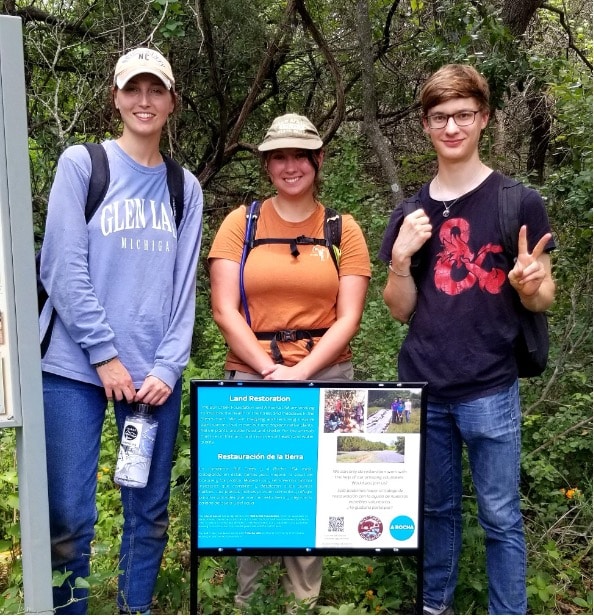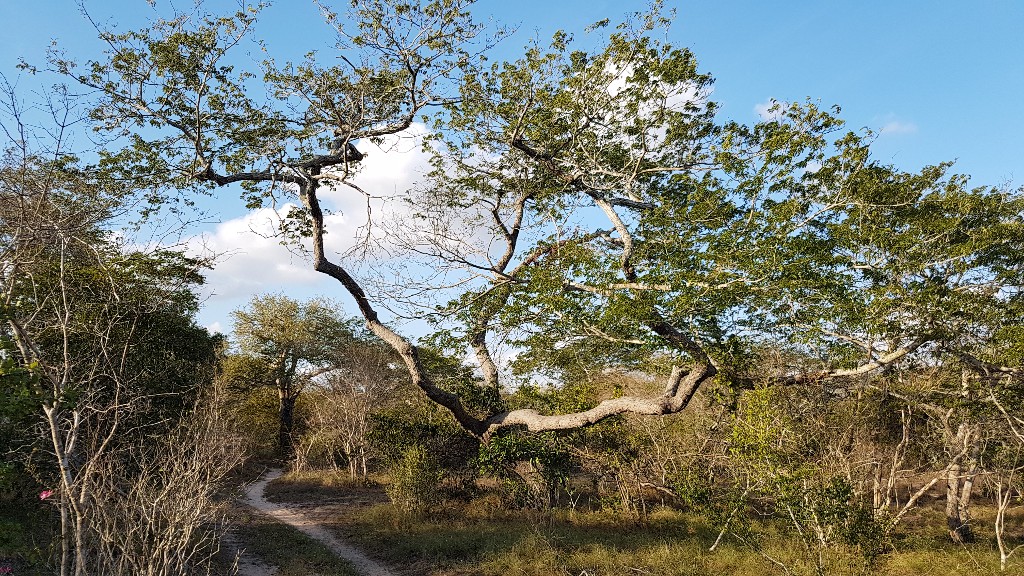An Axe Laid to the Roots: Invasive Plant Removal in the Stenis Tract

The 2023/24 ARUSA interns at the Stenis Tract. (L-R: Michaela, Maddie, Noah)
By Noah Guthrie
Beside the coiling waters of Bull Creek, three A Rocha USA interns waded through thorns, waging war against the Glossy Privet. As we heaved our shoulders through viper-green barbs, we brandished our weapons: a red flip-saw for hacking, a hawkbill knife for slitting trunks and a weed-wrench for dragging saplings headfirst from the soil.
All three of us were tree-huggers. What could have possibly compelled us to destroy these poor, ill-fated privets in the Southern US? They’re doing what God made them to do – namely, being fruitful and multiplying by their many seeds (Genesis 1:12). But they’re doing it in the wrong place.
The privets were growing in the Stenis Tract of Austin, Texas, a narrow wedge of land between Bull Creek and Spicewood Springs Road. About 57 acres, this area is a mix of open meadow and subtly sloped woodland, with myriad plants weaving through the soil: Spanish Oak, Ashe Juniper and Yaupon Holly, Cedar Sage and Bluebonnets, as well as the Live Oak – burly and mystic, arms undulating like kraken tentacles. By day, hikers and cyclists speed down the path and by night, stags nose their way between the trunks.
And then there are the invaders. King Ranch Bluestem bristles like blanched porcupine quills, Nandina flares its jade and scarlet starbursts, and canopies of privet leaves – perfectly shaped, perfectly polished, perfectly green – blot the sun, smothering the understory. As beautiful as they are, these exotic ornamentals rapidly out-compete local plant-life, lowering the overall health and diversity of the ecosystem.
Since 2021, A Rocha USA has gone to great pains to remove these plants from the Stenis Tract – focusing on the privet, since it’s especially prevalent. We’ve joined forces with the Bull Creek Foundation to host more than 15 volunteer work days, employing over 500 volunteer hours to remove over 7,500 invasive plants. Our removal methods include weeding, weed-wrenching and girdling, the latter of which starves a tree over time by removing a ring of phloem tissue from its trunk, cutting off its circulation of nutrients.
In some ways, this systematic destruction of a species is especially hard for us as people of faith. God deems all the plants of Creation ‘good’ (Gen. 1:12), the Psalmist affirms God’s loving provision for trees (Ps. 104:16), and Jesus identifies even ‘the grass of the field’ as recipients of God’s lavish and varicoloured love (Matt. 6:28-30). To girdle a privet, in other words, is to strangle a member of God’s beloved Creation. Yet, girdling is meant to support the healing of the Stenis Tract ecosystem, and the Bible offers a framework for understanding that, too. While Genesis 1 and 2 affirm the innate value of each member of the biotic community, other scriptures affirm the need to uproot certain individuals for the sake of communal flourishing.
Depending on how we interpret Old Testament law, Exodus 21:28 and Deuteronomy 17:2-7 seem to allow for destructive creatures (an ox in one case; a human in the other) to be stoned for the greater good of the Israelite community. This principle also arises in the New Testament, when John the Baptist warns the Pharisees – who oppress the socially vulnerable in Israel – that ‘the axe is laid to the roots of the trees. Every tree therefore that does not bear good fruit is cut down and thrown into the fire’ (Matt. 3:10).
If God allows for certain people to be ‘chopped down’, then maybe we can justify doing it to invasive plants as well, as long as we do it with a two-fold love. First, love for the biotic community as a whole, refusing to allow invasives to impede the flourishing of their neighbours.
Second, love for the invasives themselves, finding ways to honour them even as we’re forced to destroy them. After all, Jesus taught us to love our enemies. This tension between love and extirpation emerges among other members of the global A Rocha family, too. A Rocha Kenya, having noted the over 40,000 invasive crows distributed across the Watamu and Malindi areas in 2024, has used great quantities of avicide to try to thin them out, striving to protect local birds from the crows’ harassment and killings
Meanwhile, A Rocha Aotearoa New Zealand has removed over 14,000 invasive predators from around Mount Karioi, killing off ferrets, opossums, stoats and feral cats for the sake of native Ōi chicks. When we kill certain species, it can be hard to sustain our empathy for them. It’s easy enough to love the native and hate the invasive. What’s harder for us, as Christians, is learning to love both, even when forced to drive one of them out.
In the U.S., our Texas team has explored small ways of honouring the Stenis Tract’s invasive plants. Aside from verbally acknowledging their beauty, we’ve also fashioned laser-engraved ornaments from chopped privet wood, affirming the value of the privet’s life while also shaping it into fresh beauty. Meanwhile, we already see signs of a healthier, more diverse Stenis Tract being born. Sunlight washes through the bones of the privet canopy, painting the forest floor with native green sprouts. Across the meadows, which were once stifled by clots of King Ranch Bluestem, breezes of Bluebonnets revive the soil.
If we’re forced to destroy, let it be from a desire for restoration. If we’re forced to kill, let it be from a desire for rebirth. This is our hope for the Stenis Tract, a little resurrection garden spreading one patch of soil at a time.
If you want to support A Rocha USA’s invasive plant removal, feel free to donate to our Texas Conservation Project!



